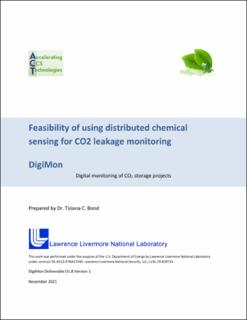| dc.description.abstract | The feasibility study focused on the development of new fiber for distributed chemical sensing (DCS) that will allow direct detection of CO2 leakages in the environment. This is particularly important for monitoring well integrity for carbon capture and storage (CCS), to provide early warning for an incoming well failure and potential CO2 leaking through it. We proposed using optical spectroscopy in optical fiber for direct detection of CO2. The main approach is based on Raman interrogation within gas-filled Holey Fibers (HoFs), so that the location and concentration of the gases would be provided simultaneously via backscattering. Additionally, Infrared (IR) Absorption Spectroscopy could also be used, and the architecture would be more discrete since interleaving with standard solid core fibers and Fiber Bragg Grating (FBG) sections is required to enable reflection to the I/O controls. The possible Raman length or the IR numbers of sections would be defined based on signal to noise ratio. The optical spectroscopy methodology would overcome current roadblocks to CCS, as fiber optics will allow for CO2 (and other gases) detection in wells with direct in-situ measurements of concentration along with other important parameters such as temperature and pressure as the baseline of environment background.
We were able to assess commercially available IR/Raman hollow core fiber and demonstrated detection of CO2 through them in our controlled environment setups. We have also established the ability of drilling precisely with pulsed femtoseconds (fs)-lasers side holes to enable penetration of CO2 into the hollow core fiber and reduce diffusion rates. Open joint collars were also explored having a double functionality: splicing to solid core fiber critical for field deployment and creating gas ingress locations. Both diffusion-only and pressurized fiber systems have been constructed following numerical simulations in COMSOL based semi-hybrid optical /fluido-dynamics models. FBGs have been identified, procured, and characterized but not yet integrated. Along the work we leveraged internal modeling/design, photonics/laser characterization, optical fiber fabrication, and AM lab capabilities to design, develop and test in-house components or assemblies. Our results indicate the critical potential that the HoF would have in the direct detection of CO2 downhole. | en_US |
